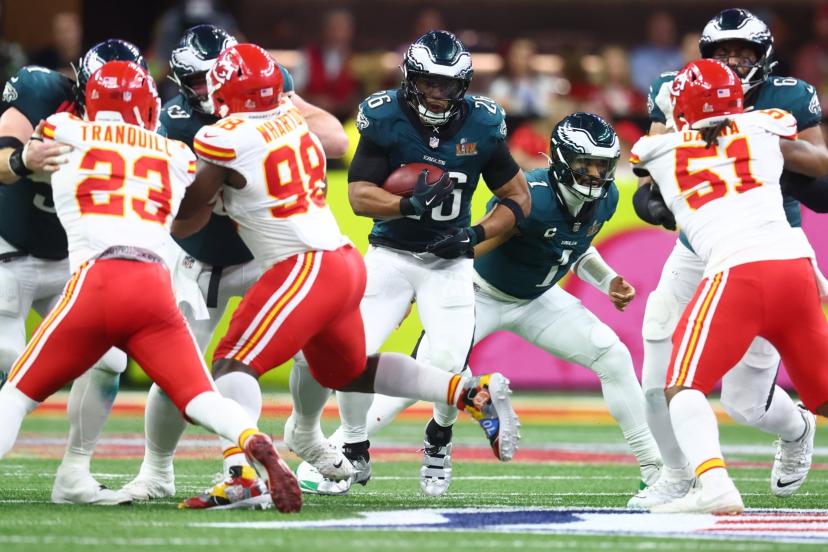In the world of the National Football League (NFL), innovation often wins games. Teams constantly search for new ways to gain a competitive advantage, whether through offensive schemes, defensive strategies, or unique plays that can become trademarks. The Philadelphia Eagles, one of the NFL’s most storied franchises, have found one such advantage in their ability to execute a play that has become synonymous with their offensive identity in recent seasons: the “tush push”. This play has garnered significant attention due to its effectiveness and controversy, with the Eagles frequently relying on it in short-yardage situations, especially when the stakes are high.
Central to the success of the tush push is the team’s quarterback, Jalen Hurts—a versatile and powerful player who is built for short-yardage situations. In fact, it is Hurts’ combination of strength, mobility, and leadership that has made the tush push one of the most dangerous weapons in the NFL. However, the play is not without its critics. As Hurts and the Eagles have used this play to devastating effect, some have called for it to be banned, arguing that it’s too effective and places undue stress on player safety. Nevertheless, as the Eagles continue to dominate short-yardage situations with this maneuver, the tush push has raised questions about innovation, player safety, and whether the NFL is ready to accept such a strategy as a permanent part of the game.
In this article, we will explore the mechanics of the tush push, why it has become such a successful play for the Eagles, the role that Jalen Hurts plays in its execution, and the debates surrounding the play, including concerns over safety and fairness.
Understanding the Tush Push: Mechanics and Execution
The tush push is a variation of the quarterback sneak, but with a unique twist. In a traditional quarterback sneak, the quarterback takes the snap and tries to push forward a yard or two by himself, often relying on his offensive line to create a gap. However, with the tush push, the quarterback is assisted by his teammates. The offensive line pushes the quarterback from behind, creating a wave of momentum that makes it nearly impossible for defenders to stop the play.
For the Philadelphia Eagles, this play is executed in a very specific manner. Typically, the Eagles use it in short-yardage situations—most commonly on third-and-one, fourth-and-one, or goal-line plays. In these situations, the Eagles line up in a tight formation, with the quarterback under center. Once the ball is snapped to Jalen Hurts, his offensive line, and often tight ends or running backs, immediately drive forward and push Hurts from behind, propelling him forward with a combination of brute strength and momentum.
While this play is not unique to the Eagles, they have mastered it, and their success with it has been unprecedented. The key to its success lies in Jalen Hurts’ physicality. Hurts is a powerful, athletic quarterback who can absorb contact and still push forward for the extra yard or two. His ability to lower his body and drive forward is critical in making the tush push work, especially when the defense is attempting to stack the line of scrimmage and stop the play.
The Role of the Offensive Line
One of the reasons the tush push has become so effective for the Eagles is the strength and cohesion of their offensive line. This is not a play that can succeed without a dominant front five, and the Eagles have one of the best in the NFL. The offensive line plays a pivotal role in creating the necessary push and leverage for Hurts to move forward.
In many ways, the success of the tush push is a reflection of the Eagles’ overall offensive philosophy. Coach Nick Sirianni and offensive coordinator Shane Steichen have built an offense that is both physical and innovative, utilizing the strength of the offensive line to control the line of scrimmage in short-yardage situations. The offensive line’s ability to win the battle up front is a fundamental factor that allows Hurts to gain the yardage needed for the play to be successful.
Jalen Hurts’ Physicality: The Key to the Tush Push
At the heart of the tush push is Jalen Hurts, a quarterback who brings a unique set of attributes to the table. Hurts is not only known for his arm strength and ability to make plays in the passing game, but he is also a phenomenal runner—one of the most powerful and dynamic quarterbacks the NFL has ever seen. His ability to combine speed, agility, and strength in short-yardage situations is what makes him the perfect candidate for executing the tush push.
While many quarterbacks may be able to execute a traditional quarterback sneak, Hurts’ physical attributes make him particularly effective in pushing the pile forward. Standing at 6’1” and weighing around 223 pounds, Hurts is built like a running back, which allows him to drive forward even when defenders are pushing against him. His lower body strength is exceptional, allowing him to churn his legs and gain those critical extra inches when needed.
Additionally, Hurts’ understanding of the situation is crucial to the success of the play. He is known for his leadership, his ability to read defenses, and his calmness in high-pressure situations. Hurts’ poise in moments when the game is on the line—whether it’s a fourth-and-inches or a crucial goal-line situation—makes him a perfect fit for a play that requires both physicality and mental toughness.
Another element that makes Hurts so effective in these short-yardage situations is his decision-making. Unlike traditional quarterbacks, who might be hesitant to dive headfirst into a pile of defenders, Hurts is confident in his ability to push forward with the support of his teammates. This confidence allows him to not only execute the play effectively but to also remain unflappable in situations where the pressure is at its peak.
The Tush Push: A Weapon in Short-Yardage Situations
The tush push has proven to be a nearly unstoppable weapon for the Eagles in short-yardage situations, and they have used it to great effect in a variety of scenarios. Whether it’s a fourth-and-1 in the middle of the field, a goal-line stand, or a crucial third-down play, Hurts and the Eagles’ offense can rely on the tush push to move the chains and keep drives alive.
In the 2022 NFL season, the Eagles set an incredible record for fourth-down conversion percentage, with much of their success coming from the tush push. According to advanced metrics, the Eagles converted nearly 100% of their fourth-and-1 attempts, thanks in large part to the strength and precision of the tush push.
The Eagles’ success rate on short-yardage plays has been unmatched, and Hurts’ ability to execute the play under pressure has been a key factor in the team’s overall offensive efficiency. The tush push has become a go-to play for the Eagles in high-leverage moments, and it’s a play that opposing teams have yet to consistently stop.
Teams that try to stop the tush push often find themselves overwhelmed by the sheer strength and coordination of the Eagles’ offensive line and Hurts. Defenders can stack the line, but when the Eagles get a full push from their offensive line and Hurts starts churning his legs, it’s nearly impossible to stop the momentum. The result is a first down or a touchdown, depending on the situation.
Impact on Game Strategy
The tush push has also had a significant impact on game strategy. For opposing teams, defending against this play has become a focal point of preparation. Coaches have to spend extra time during the week devising ways to stop the Eagles’ short-yardage offense, knowing that if they don’t, they’ll risk giving up critical conversions that could swing the game in the Eagles’ favor.
For the Eagles, the play has added an element of psychological pressure to their opponents. When facing the Eagles in short-yardage situations, opposing defenses know that the tush push is coming, but they still struggle to stop it. This inevitability can wear down a defense over the course of a game, as players tire and the physical toll of trying to stop Hurts and his offensive line becomes more difficult.
The Debate: Should the Tush Push Be Banned?
While the tush push has been a weapon of choice for the Eagles, it has also sparked significant debate within the NFL. Some have argued that the play is too effective and that it gives the Eagles an unfair advantage, particularly when other teams struggle to replicate it. Others believe that the play is a part of the natural evolution of the game and should be allowed to remain as a valid strategy.
The primary concern voiced by critics is player safety. The tush push involves significant physical contact, with multiple players pushing the quarterback forward. Opposing defenders must engage in a battle of strength against the Eagles’ offensive line, which can create dangerous collisions. The concern is that the sheer power exerted in these situations could lead to injuries, particularly neck or back injuries for the quarterback or defensive players who are involved in the pile.
Another argument against the play is that it violates the spirit of football. Some argue that the tush push isn’t a true representation of skill and strategy, as it relies heavily on brute force and momentum rather than finesse or precision. The concern is that the play is simply a shortcut, allowing a team to gain an advantage through physicality rather than outsmarting the opposition.
On the other hand, proponents of the tush push argue that it is simply a legal innovation—one that capitalizes on the strengths of the players involved. They point to the fact that other teams could replicate the play if they chose to build the necessary personnel, just as the Eagles have done with Hurts and their offensive line. In this view, the play is no different from other tactical advantages that teams have historically sought out, whether it’s a no-huddle offense, a wildcat formation, or RPOs (run-pass options).



